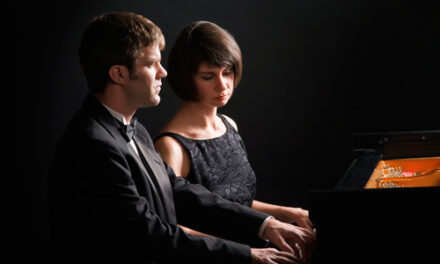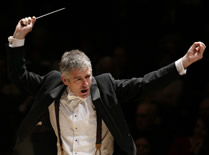It’s been many a day since a G&S crew has scrambled on board at ECU, but Her Majesty’s Ship Pinafore recently made its way inland to A.J. Fletcher Recital Hall, where yet another generation of scallywags and dainty maids charmed an audience, and proved the current School of Music Opera Theatre a capable standard-bearer of the Gilbert and Sullivan tradition. The operetta H.M.S. Pinafore, W. S. Gilbert and Arthur Sullivan’s first blockbuster hit, has enjoyed enormous success since its premiere at London’s Opera Comique in 1878. The characters and story line were inspired by several of Gilbert’s Babs Ballads, satirical verses that poked fun at the English establishment of their day.
The story takes place on the quarter deck of the Pinafore. Fletcher’s brightly-lit stage was flanked by the ship’s stem and stern, rigging crisscrossed above, and sunset colored the sky beyond the ship’s balustrade. The performance commenced with the ship’s crew dashing in for the rollicking chorus, “We Sail the Ocean Blue,” a striking sight and sound in their white sailor pants, red-striped shirts and royal blue sailor jackets. The choruses of this production, if they did not steal the show, came close to doing so, due to excellent ensemble, precise enunciation, and bits of campy theatrics thrown in for fun.
The familiar plot revolves around a love triangle that crosses social classes. The humble sailor Ralph Rackstraw believes that in vain he “loves a lass above his station,” the captain’s daughter Josephine. It becomes evident that she secretly loves him as well, despite his lowly status. Captain Corcoran, “and a right good captain, too,” has arranged her marriage to the First Lord of the Admiralty, Sir Joseph Porter, K.C.B. Despite Porter’s exalted position he is an empty suit. The crusty pirate Dick Deadeye tries to protect Rackstraw from ill-conceived desires, and the mystical peddler-woman, Buttercup, unwittingly holds the solution to the lovers’ dilemma. As the story progresses, Rackstraw and Josephine succumb to their ill-suited affections. When the Captain and Sir Joseph learn of this, Ralph is about to be thrown into the dungeon when Buttercup makes a dramatic confession: “A many years ago” she switched two babies, one of patrician birth and the other lower class. She announces that the children were Captain Corcoran and Ralph Rackstraw! Class pride turned on its head, Rackstraw embraces Josephine. Sir Joseph’s attachment to Josephine now unacceptable, he succumbs to the attentions of one of his “sisters and his cousins and his aunts,” Cousin Hebe. Lastly, Buttercup, harboring an infatuation for the erstwhile Captain, and viewing his love as now within her grasp, latches onto him (age differential aside!), completing the Gilbertian-style improbable pairing of the leads.
Ralph Rackstraw was played by Timothy Messina (alternating performance, Joshua Allen), whose light tenor voice was perfectly suited to the part. Graduate student Martha Boger was less flamboyant than the typical Buttercup (alt. Nicole House), but was well cast overall and did justice to her vocal score. Graduate student Harris Ipock’s appearance and voice were well-suited to the role of Captain Corcoran (alt. Bryan Pollock), and Ipock captured the essence of the character’s British reserve. Coloratura Jessica Laliberté’s Josephine (alt. Katy Avery) was a delight in every respect, from shimmering arias to winsome manner. As for Sir Joseph, one cannot imagine a more cheerily self-enamored fop, as played by Luke Hancock (alt. Randy Toler), whose hilariously conceived character generated much laughter. Graduate student Eddie Adams played Dick Deadeye for all performances. Director John Kramar gave Adams two additional songs, rewriting the lyrics of the Mikado’s “Tit-willow” (“Deadeye, Dick Deadeye, Dick Deadeye”) and Sullivan’s “The Lost Chord” (“Seated one day at the seashore…”). The clever lyrics were particularly funny for those who know the originals. So the suitcase aria was revived, but from the luggage of the director rather than the singer.
Congratulations are due director John Kramar, Interim Associate Dean of the College, for a highly entertaining production. Daniel Bara, Director of Choral Activities, drew from the orchestra a full expression of the music’s vitality while showing sensitivity to vocalists’ concerns, and he no doubt had a hand in preparing the choruses. Lead roles were double-cast for the four performances (“alt.” above not an indication of status), paired as follows: Thursday evening and Saturday at 2 p.m.; Friday and Saturday evenings at 7 p.m.












